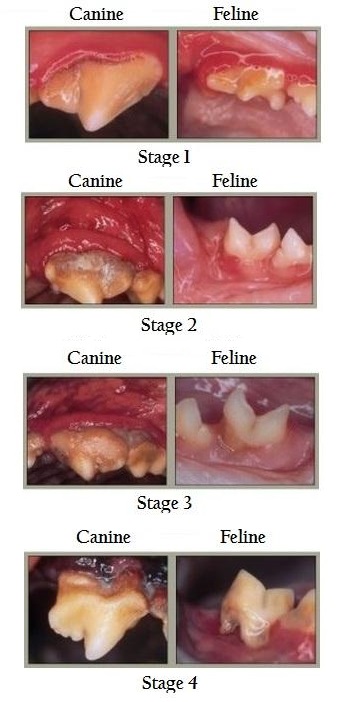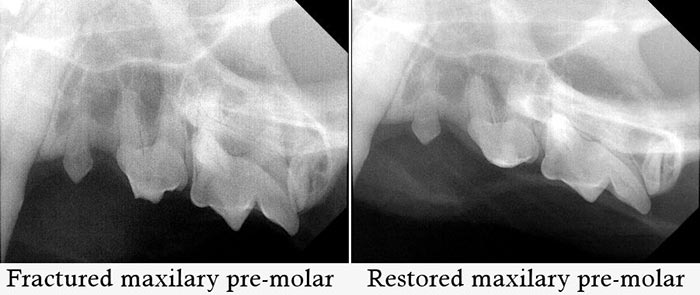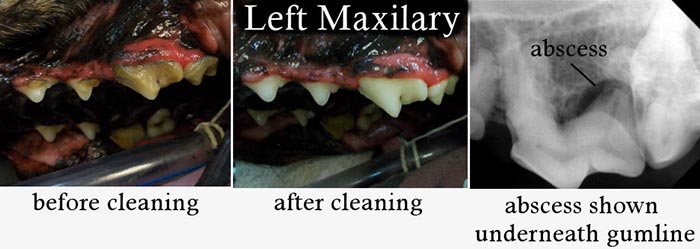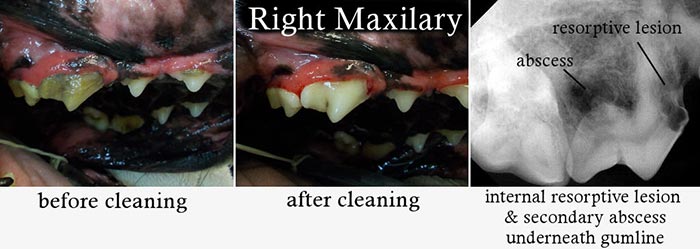Dental Care
We know you want the best for your pet and often pet owners are nervous about taking their pet for a veterinary dental cleaning because they are fearful about their pet being put under anesthesia for the procedure. First, we want to reassure pet owners that under the correct protocols, anesthesia is very safe and is far less dangerous than the periodontal disease that will develop without proper cleanings. Here are some questions we would like to answer for your about our dental procedures
What is Periodontal Disease?
Periodontal disease is no different in pets than in humans. Periodontal disease is the destruction of bone, gum tissue and structures that hold teeth in place. Periodontal disease is caused by bacterial infection that spreads, unseen, beneath the gumline. As the disease progresses, it destroys the bone around the tooth roots leading to mobile, painful teeth. Dogs and cats with advanced periodontal disease often require oral surgery to extract many teeth.

How Do I Know If My Pet Has Periodontal Disease?
The truth is that you don’t. Unfortunately, by the time there are obvious indications of periodontal disease, such as bad breath and loose teeth, there is already significant damage. Periodontal disease begins and exists under the gumline where it is not visible. White teeth do not mean that your pet is free from disease. The only way to prevent or identify periodontal disease early is through regular veterinary dental cleanings under anesthesia, where the pet’s mouth is thoroughly evaluated, cleaned and all the teeth are radiographed to identify bone loss, periodontal pockets and other disease involving the tooth root and surrounding bone.
How Can I Prevent Periodontal Disease?
Fortunately periodontal disease is very preventable. There are two key components to preventing periodontal disease in your pet – home dental care and annual veterinary dental care. Imagine what your own mouth might be like if you never brushed your teeth. Your pet’s mouth is no different. Daily brushing remains the gold standard to prevent plaque and calculus and slow the progression of periodontal disease. In addition, there are diets, treats, chews and water additives that have the Veterinary Oral Health Council seal of acceptance that can be used to assist you with your pet’s preventive oral healthcare program. An annual visit for a veterinary dental cleaning is an important part of your pet’s oral health care program. Annual dental procedures under general anesthesia allow your veterinarian to visually examine each tooth and use a dental probe around each tooth, in addition to obtaining radiographs to evaluate the tooth structure that cannot be seen with the naked eye. When you do this regularly, your pet’s mouth is evaluated, thoroughly cleaned and any bacteria or beginnings of periodontal disease can be addressed immediately before it causes extensive and expensive damage. Your pet will thank you with a clean and healthy mouth!
Bloodwork
Bloodwork is mandatory for all our dental patients because this helps us evaluate your pet’s internal organ functions and allows us to better know if your pet is healthy enough to go under anesthesia.
Monitoring
Your pet is always monitored when they are under anesthesia. This means one of our trained veterinary technicians closely monitors your pet’s blood pressure, blood oxygen saturation, electrocardiogram, respiratory rate and body temperature. Intravenous fluids are also administered throughout the procedure to help maintain your pet’s blood pressure and provide intravenous access for additional drugs if they are needed. Your pet is always kept warm with warming blankets during the procedure.
Your Pet’s Health is Our Number One Priority!
Dental radiographs are one of the most important diagnostic tools available to veterinary dentistry.
Dental radiographs allow the internal anatomy of the teeth, the roots and bones surroundings the teeth to be examined. Without dental radiographs it becomes a guessing game as to which teeth are healthy and which teeth are painful and disease-ridden. Dental radiographs allow us to treat your pet without any guessing. Intra-oral radiographs are made using digital sensors placed inside the patient’s mouth, and provide superior quality for examination of individual teeth or sections of the jaws compared with standard-sized veterinary radiographs. Because veterinary patients will not cooperate when a radiograph or sensor is placed in the mouth, taking dental radiographs requires that the patient is anesthetized or sedated.
Here are a few cases we would like to share with you so you can see the importance of the dental care we offer and how we have helped our patients live their best lives!
Augusta
Augusta is a feline patient of ours who came in for an anesthetic dental. He had an enamel fracture to his left maxilary pre-molar and we were guessing it would need extracting. Because of our dental radiographs we were able to better see the bone and under the gumline to confirm exactly what was going on and if it was causing him pain. As you can see with the dental radiograph here, his picture showed there was no nerve exposure. He was able to keep the tooth! Just like a human fracture, we were able to restore the defect with a light cured composite material – sealing the vital nerve of the tooth. If it weren’t for our dental radiographs, then we would have pulled the tooth thinking it was an issue – what a mistake that would have been!

Saint
Saint is a canine patient of ours who came in for an anesthetic dental. He had dental care in the past without radiographs. Came in with moderate periodontal plaque and gingivitis. His oral radiographs showed he had several cavities. These were exposing the vital nerve of the tooth, therefore causing severe pain and infection. Without radiographs we would have never found this and Saint would have continued to live in pain. We were able to extract all the painful and infected teeth.


Annie
Annie is a canine patient who had a condition called base narrow. This is a condition where her lower canines were causing trauma to her maxilary palate. To correct this we shortened, restored, and crowned these teeth with a cast metal crown for long term.

If your dog or cat is showing any of these signs, then a dental examination may be recommended by one of our veterinarians
Bad Breath
Contrary to popular belief, it’s not “normal” for your pet to have bad breath. It may be common in pets, but that’s typically because the pet doesn’t get regular dental brushing and cleaning. Bad breath is the most frequent sign of dental problems. Bad breath could indicate the presence of periodontal disease. Even if it’s only mildly bad, it means bacteria is trapped in the pet’s mouth.
Eating Difficulties
If you see your dog or cat having difficulty chewing their food or suddenly losing their interest and appetite, she might need urgent dental care. These symptoms can indicate oral infection or inflammation.
Problem Gums
When your pet develops inflamed, swollen or bleeding gums, this is often a symptom of a bacterial infection. The inflammation can cause significant pain and discomfort, but can often be reversed by having a professional dental cleaning or removing an offending tooth.
Stained Teeth
Yellow and brown stains on the back of the pet’s teeth and around the gum line are signs of tartar build-up. These go hand-in-hand with bad breath and bacterial infections, but can usually be removed by a professional cleaning before they become problematic. Of course, if you’re brushing your pet’s teeth daily you can avoid this happening in the first place and maintain your pet’s general good health.
Loose and Broken Teeth
You might think it’s normal for your cat or dog to lose teeth as she gets older, but loose and broken teeth are often signs of a more serious dental issue. If bacteria has eaten away the binding that holds the tooth in place, an infection probably exists or is in the process of developing. A loose tooth can also be caused by chewing on something too hard, which might open the root of the tooth and result in infection. Any oral bacterial infection can spread to the rest of your pet’s mouth, and eventually to the rest of the body.
Tumors on Gums
Tumors or growths on your pet’s gums could be benign or malignant, and the only way to find out is to have her examined by a veterinarian without delay. If a tumor is found to be malignant, the treatment might require the removal of some of her teeth and/or a section of her jawbone. Pet parents who brush their dog’s or cat’s teeth daily are more likely to notice tumors in early stages, which is an additional reason to practice good pet dental care.
Pawing and Drooling
If your pet begins drooling excessively or pawing at their face, then they could have a dental abscess that is causing a lot of pain and discomfort. The carnassial tooth or fourth upper premolar tooth is particularly prone to developing abscesses, usually as a result of: trauma to the tooth, fighting, chewing hard items, and bacteria from periodontal disease.
Practicing regular pet dental care can prevent many of these problems. If your pet develops signs of dental disease, the sooner they receive treatment, the more likely they are to heal completely.
If you’d like to learn more, click on the individual documents below to read and learn!
Could My Cat or Dog Have Periodontal Disease?
Brush My Cat’s or Dog’s What?!
Frequently Asked Dental Questions and their Answers
Feline Odontoclastic Resorptions and Stomatitis
Dental Anesthesia
Consil – Savior for Some Hopeless Teeth
Name that Bite
What to Expect If Your Pet Needs Dental Care
Did you know that you can add 2-4 years to your pet’s life with proper dental care?
Dental hygiene is an important part of of your pet’s health and can often be the cause of serious illness. If left untreated, dental problems can lead to larger systemic issues in your pet due to oral bacteria entering the bloodstream and damaging the kidney, heart and liver. It is estimated that more than 80% of dogs and 70% of cats over the age of three have dental disease.
Your pet’s annual check up and dental cleaning is the best way to promote healthy teeth and gums. Every dental cleaning involves scaling and polishing the teeth both above and below the gumline and full mouth digital x-rays to help detect tooth and bone loss.
Pet Dental Care in DeLand, FL
To make an appointment for a dental exam or cleaning, call us at (386)734-9899.
Explore Our Complete List of Veterinary Services in DeLand
- Urgent Care
- Tumor Specific Electroporation
- Radiology
- Ultrasound
- Stem Cell Therapy
- Reiki
- Ozone & Prolozone Therapy
- Sanawave Therapy
- Microbiome Replacement Therapy
- Nutrition
- Meridian Stress Analysis
- Kinesiology Taping
- Intravenous Vitamin C
- Homeopathy
- Laser Therapy
- Exotic Pets
- Echocardiogram
- Cancer Care
- Body Alignment
- Acupuncture
- Vaccinations
- Wellness Exams
What's Next
Call us or Schedule an Appointment Online
Meet With a Doctor for an Initial Exam
Put a Plan Together for Your Pet

